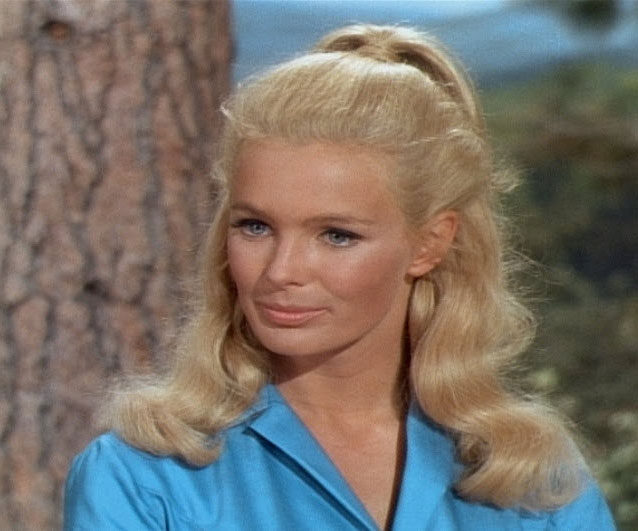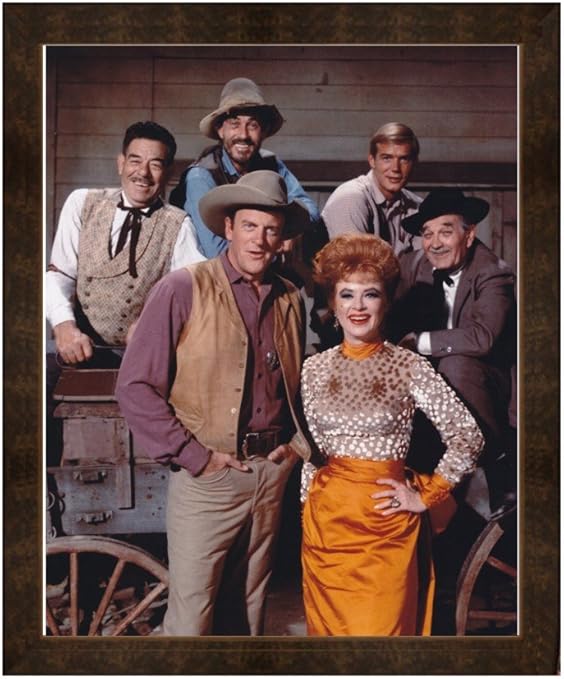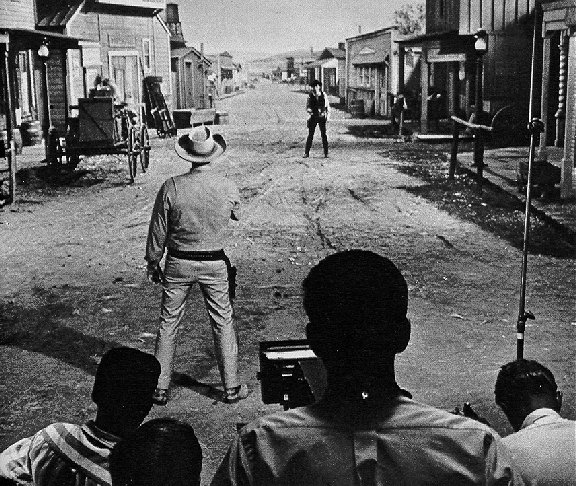As we wind up our series on Westerns, today we look at what was the most popular western, even if it wasn’t the longest-running: Bonanza created by David Dortort. Dortort was also the executive producer for The Restless Gun and High Chaparral, so he knew something about westerns. Debuting in 1959, the show would continue on the air until 1973, resulting in 431 episodes from its 14 seasons.

Set in the 1860s, the show features the Cartwright family who live in Virginia City, Nevada near Lake Tahoe. The title comes from a term used by miners to describe a large deposit of silver ore.
Ben Cartwright (Lorne Greene), a former ship captain from New Orleans, is raising his boys after three of his wives have passed away; each boy had a different mother: Adam (Pernell Roberts), the oldest, is a well-educated architect who built their house; gentle and kind-hearted Eric “Hoss” (Dan Blocker) helps his dad on the ranch as does the youngest and hot-headed Joe (Michael Landon). Hop Sing (Victor Sen Yung) is the family’s Chinese cook. Their ranch is called the Ponderosa after the Ponderosa pines. The men often go into town to see different neighbors, most often the sheriff Roy Coffee (Ray Teal) and deputy Clem Foster (Bing Russell). Another recurring role was “Candy” Canaday (David Canary), the ranch’s foreman.

Roberts decided to leave the show in the mid-sixties and it was said that Adam went to sea and later that he settled in Australia. In 1972, Blocker passed away from a pulmonary embolism after gall bladder surgery. The storyline was that Hoss saved a woman from drowning but lost his life doing it. Another actor to leave the show early was Canary after a contract dispute in 1970, although he later returned in 1972.

The show concentrated more on relationships than action. The storylines were about taking care of family members, neighbors, friends and seeing justice done. This was one of the first series to feature both comedy and drama. However, I have to say, you did not want to be cast as one of the Cartwrights’ love interests; every time one of the boys got serious about someone, they died from some disease, were killed, or went off with some other man. It was also just dangerous to hang out with this family; during the course of the show, Joe was shot 18 times, Ben was shot 14 times, Hoss was shot 11 times, and Adam was shot 6 times. The show also tackled some tougher topics including racism and anti-semitism.

Landon liked to tell a story about how tough Blocker was. He said during shooting one day, Dan’s horse fell and threw him. Getting up, the collarbone was actually protruding from his skin. Dismissing the crew’s pleas to go to the hospital, he stuck the bone back in place and resumed filming. At the end of the day, he did go to the hospital to have the bone set.
Landon also liked sharing a story about Greene. He was required to jump off a small ledge into a lake five feet below him. Greene did his own stunt and when he hit the water, he went completely under. His hairpiece floated to the top so the rest of the crew watched to see what would happen. Greene’s hand came up and grabbed the toupee and then it disappeared underwater until Greene emerged with his hairpiece askew and walked past the crew who were uncontrollably laughing. Greene was not the only member to wear a toupee though. Roberts and Blocker wore them, and Victor Sen Yung had an attached ponytail.

And Landon, although he had his own hair, dyed it from the beginning since he began going gray at age 20; he also wore 4-inch lifts in his shoes.
Landon was also interested in the behind-the-scenes processes for the show. He made several attempts at writing a script; eventually Dortort accepted one, and from that point on, Landon became a regular writer and director for the series.

The show received a time spot on Saturdays at 7:30 ET and the ratings were decent, but they could not beat Perry Mason, one of their competitors. The show was expensive to produce, but NBC stayed with it because it was one of the first series filmed in color. RCA was NBC’s parent company and they manufactured colored television sets.
For season three, Bonanza moved to Sunday nights at 9 ET. The ratings increased significantly and the show reached number one in 1964 and continued in that spot till 1967 when it went up against The Smothers Brothers Comedy Hour. The show didn’t fall out of the top ten until 1971.

One interesting production note about this show is that from the third season on, the Cartwrights and recurring characters wore the same clothing for almost every show. There were two primary reasons for this implementation. One is that it made it easier for stunt doubles. (Hal Burton, Bob Miles, Bill Clark, and Diamond Farnsworth among others. I really need to do a blog on stunt men. The careers of these men are pretty impressive.) It also allowed action shots to be filmed once and then used over and over; for example, when characters were riding a horse, it wasn’t filmed all over again every episode.
The popular theme song was written by Jay Livingston and Ray Evans, orchestrated by David Rose, and arranged by Billy May. When the music began, we saw a map of the Ponderosa and the Cartwrights on their horses. For season thirteen, a new song, “The Big Bonanza” was written for the show, and the original theme came back for the last season in a faster rendition. Many musicians recorded the song, including Johnny Cash and a Bonanza soundtrack album was released in 1961. When the songwriters were interviewed for the Television Archives, they said Desi Arnaz asked them to write the theme and said he had very little money to pay them and thought the show might only last a year. They made a deal to keep the rights to the song instead of receiving a weekly paycheck. To their surprise, the show was a long-running hit, and they made millions of dollars from the song.

The opening scene was shot at Lake Hemet in California but later moved to Lake Tahoe. The horses in the scene were rented from Idyllwild Stables in California. There was a set for Virginia City which was used till 1970; it was on the backlot of Paramount (you can also see it in Have Gun—Will Travel, Mannix, and The Brady Bunch). From 1970-73, the switch was made to a less expensive Warner studio. The ranch house was recreated in Incline Village, Nevada in 1967. It remained a tourist attraction until it was sold in 2004 for an estimated $38,000,000.

Once the series began full production, they rented horses from Fat Jones Stables in North Hollywood. The company rented horses for movie and television production beginning in 1912. Joe rode Cochise, Hoss rode Chub, and Adam rode Sport which were not their real names. Greene apparently did not enjoy riding horses, including his named Buck on the show. However, when the series was cancelled, Lorne bought his horse from the stable because he was fond of him. He donated “Buck” to a therapeutic riding center in California where he lived till passing away in 1992.
Although the Cartwright men rode horses, Chevrolet was its sponsor for most of its television run. The stars often appeared on commercials endorsing the cars.

Like so many of the sixties shows, if you liked the series you had a lot of products you could buy to support the show. In addition to comics, books, action figures, and lunch buckets, there were Jim Beam whiskey decanters, View Master reels, collector plates, and more unique, a chain of Bonanza and Ponderosa steakhouses. Blocker owned the chain originally called Bonanza, similar to the Golden Corral ones. When ownership changed, both the restaurant chains were purchased by the same owner and renamed Ponderosa.

In 1972, NBC moved Bonanza to Tuesday nights where it was up against All in the Family and Maude. They were unable to compete; ratings plummeted and the show was cancelled.
The shows have been in syndication since they went off the air and can currently be seen on several channels. Recently they have been aired on MeTV and Encore Westerns as well as Hallmark.
Three made-for-television movies were produced about Ben’s grandchildren–Bonanza: The Next Generation (1988), Bonanza: The Return (1993), and Bonanza: Under Attack (1995).

Although Gunsmoke was the longest-running western, there is something about Bonanza and its fan base that makes it different. Like the Andy Griffith Show, there is a group of people who adore the show. Fan clubs abound on the internet, many books have been written, and people who love the show learn all the details of their favorite stars and episodes. Recently, I learned that my sister-in-law named our nephew Ben because of Ben Cartwright; who knew? If you are one of these devoted fans, I don’t have to convince you to check out some of the episodes, but if you haven’t seen the show or it’s been a while, take some time to ride with the Cartwrights and explore the Nevada from the time of Abe Lincoln.























